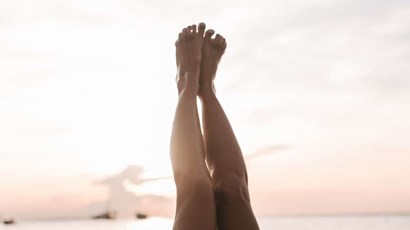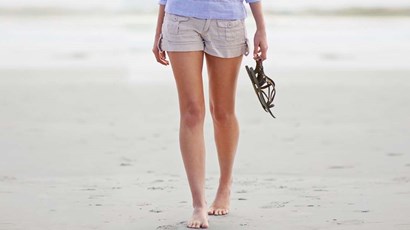Spider veins: why is winter leg care so important?

How to prevent varicose veins
Varicose veins will affect nearly one third of us at some point in our lives. For those who do develop these visible and protruding leg veins, another third will experience symptoms of depression. Unfortunately, we can't prevent varicose veins from developing, but by following five healthy lifestyle habits we can slow down their progression and minimise discomfort.
What causes varicose veins?
You may have heard of varicose veins, a fairly common condition that around 30% of the UK population will develop during their lifetime1. What you may not know is that varicose veins aren't always obvious. This can mean that many of us neglect to follow the lifestyle habits that support our vein health.
"In their simplest form, varicose veins can be identified as bulging veins which protrude from the legs," explains Professor Mark Whiteley, leading consultant venous surgeon and founder of The Whiteley Clinic. "However, up to half of all varicose vein sufferers will show no overt signs of the condition, as the problematic veins remain hidden under the skin. We call these 'hidden varicose veins'.
"Most people have a combination of causes for their varicose veins or 'hidden varicose veins' and so it is essential that all the causes are found and treated. This is why the NICE guidelines say that patients with varicose veins need to be seen by doctors working in teams2."
- The first cause - a number of small communicating leg veins (perforators) that take blood in from the skin to the deep veins in the muscles. When their valves fail, blood is released into the surface veins.
- The second cause (pelvic congestion syndrome, or PCS) - a medical condition caused by internal varicose veins in the lower abdomen and pelvis, which cannot be seen on the surface.
Symptoms of varicose veins
Not everyone will experience the same symptoms, but Professor Whiteley shares a helpful mnemonic device listing some of the key indicators to keep an eye out for:
V - Veins which are visible on the surface of the skin, or just underneath it.
E - Enlarged veins that are blue or dark purple in colour.
I - Itchy, sore or dry skin just above the ankle or over the bulging veins.
N - Nodular, hard, and tender veins.
S - Swollen, achy or heavy legs and ankles.
Are varicose veins dangerous?
Sadly, even though they happen to a lot of us, visible varicose veins often affect people's self-esteem. One study of 100 people even found a strong link between varicose veins and undiagnosed depression3.
The appearance of them is often a driving force for people becoming interested in how to prevent varicose veins. Yet, Professor Whiteley also stresses that it is a common misconception that this condition is solely a cosmetic issue: if treatment for varicose veins is ignored, they can go on to cause a lot of problems.
"This is why the NICE guidelines2 say that varicose veins with any symptoms or signs should be scanned and treated in specialist units," he adds.
Possible health problems
Professor Whiteley says:
- Blood clots - superficial vein thrombosis (SVT) and deep vein thrombosis (DVT) are blood clots that develops within a vein.
- SVT (also called phlebitis) - the clot is in the superficial veins and appears as a hard, red, painful lump. If the SVT gets within 5-7 cm of the deep vein, it can throw a clot off to the lungs - a pulmonary embolism (PE). Anyone with SVT, or 'phlebitis', MUST be referred for a duplex scan to see if they need anticoagulation.
- DVT - a clot in the deep veins that usually does not move, but if left untreated can cause scar tissue in the wall. This can result in swollen, discoloured and painful legs, and sometime leg ulcers, a condition called post thrombotic syndrome (PTS). In more serious cases, DVT can lead to PE.
- Leg ulcers - research suggests that one in 20 people with 'simple' varicose veins will go on to experience leg ulceration if left untreated. Leg ulcers occur when the skin has broken down to reveal open sores which are unable to heal naturally and can often become infected if not treated correctly. However, they can now be treated, and even prevented, by local anaesthetic varicose vein surgery.
Can you prevent varicose veins?
Unfortunately, some of the risk factors for varicose veins are unavoidable - for example, your age, family history of the condition, and being female. Other risk factors in your life can also increase your risk; these include obesity, hormone replacement therapy, and pregnancy (the risk increases by 82% compared to people who have never been pregnant4).
Spider veins: why is winter leg care so important?
Spider veins are a common condition and are usually no cause for concern. However, it's importan...
"You cannot prevent varicose veins," says Professor Whiteley. "However, there are some things you can do to minimise any discomfort in your legs, and slow down the progression of the problem if you do have varicose veins or 'hidden' varicose veins."
Vein Health Awareness Week falls in September each year. Started by Professor Mark Whiteley, this aims to raise awareness of the importance of good vein health, how to spot venous disease, and when to get checked.
Let's explore the five healthy lifestyle habits that can aid prevention of varicose veins and help to delay problems with your veins.
1. Elevate your legs
"Raising your legs while you're sitting will help to lower the pressure in your legs by allowing blood that has pooled in the veins to drain away, helping to prevent skin damage and blood clots," advises Professor Whiteley.
"This is a simple daily habit that we can adopt while on the sofa. If you work at a desk from home, you could even prop up your legs while working using a footstool or cushions."
2. Get moving
"It is very important for you to 'get moving' every hour to help keep your blood circulation working. Sitting or standing for long periods of time can make it harder for your blood to travel in the leg veins against gravity. This causes an increase in pressure in the veins, resulting in blood beginning to pool around the ankles," says Professor Whiteley.
3. Exercise regularly
We know that regular exercise supports our health in all sorts of ways, from keeping our hearts healthy to regulating our weight. Preventing varicose veins may be one of the lesser-known reasons to work out.
"Low-impact exercises such as yoga are particularly good at improving blood circulation," Professor Whiteley adds. "The bending and stretching movements involved in the practice help to compress and decompress the blood vessels."
4. Watch your diet
Being overweight or obese increases the pressure in the veins lower down in your legs and could cause your ankles to swell. Therefore, a poor diet that is high in saturated fats and sugar is a risk factor for varicose veins.
To lose weight in a healthy and safe way, make sure you eat a nutritious diet made up of all the food groups5, including lots of fruit and vegetables, and be mindful of the recommended daily calorie intake for your sex.
5. Wear supportive socks or stockings
Supportive stockings from your doctor - also called graduated pressure or compression stockings - can help to relieve aching legs. Professor Whiteley advises that even ones that sit below the knee can make your legs feel much better. These are often prescribed after your doctor has checked there are no problems with the arteries in your legs. Professor Whiteley also recommends getting a venous duplex ultrasound to check for vein problems and complications.



